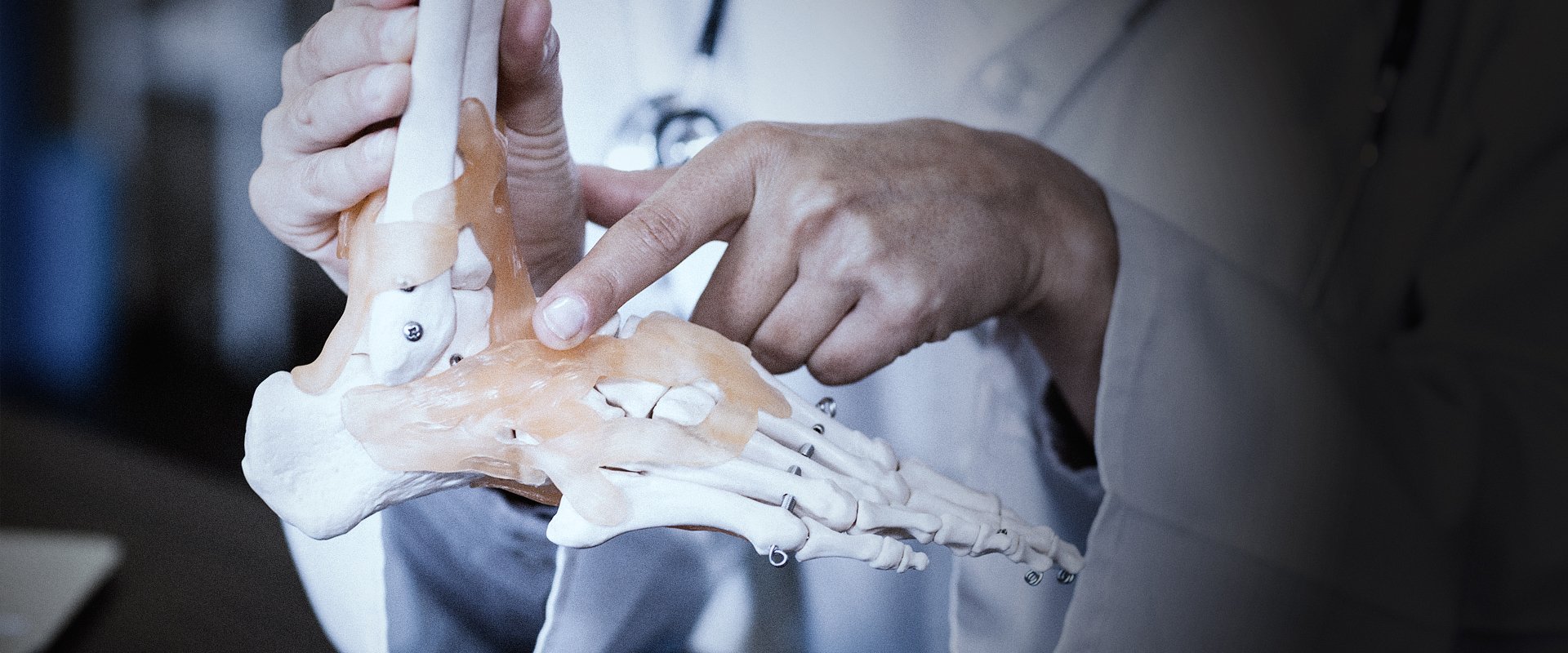
Physical Therapy for Deltoid Ligament Strain
AT EVOLVE
Physical Therapy for Deltoid Ligament Strain
HOW CAN PHYSICAL THERAPY TREAT A DELTOID LIGAMENT SPRAIN?
Sprained ankles can range from a short-lived nuisance to a major disruption. Sprains affect the ligaments in the ankle and are typically classified into low and high-ankle sprains. A deltoid ligament sprain is a type of low ankle sprain, affecting the inside of the ankle, commonly treated by physical therapists. Physical therapy is a great tool to help recover from an ankle sprain. The role of physical therapy is to promote healing of the sprained tissue, facilitate return to activities and reduce the chance of future sprains.
WHAT DOES PHYSICAL THERAPY FOR A DELTOID LIGAMENT SPRAIN LOOK LIKE?
When you begin rehab for a sprained ankle, my staff and I will apply the best, evidence-based techniques to address your symptoms. We will start with an initial evaluation to better understand your medical history and the pattern of symptoms you are experiencing. We will discuss your goals for physical therapy and perform an examination to assess your ankle and any other areas of the body that may contribute to your symptoms.
With all of this knowledge in hand, we will create a custom program that may consist of hands-on techniques performed by our therapists on your ankle and nearby areas combined with carefully prescribed movements and exercises performed by you in the clinic and at home to help the sprain heal and the ankle to recover. The program is typically graded, beginning with low-impact exercises and progressing to more advanced training as you approach full recovery.
HOW LONG WILL I NEED PHYSICAL THERAPY?
Low and moderate-grade deltoid ligament sprains may require 4-6 weeks of physical therapy. Higher-grade sprains may take several months to heal fully thus your physical therapy program will be longer. The activities you are looking to resume also influence the length of your plan of care. An athlete looking to return to running on rocky trails may need more rehab than an individual who only walks on even sidewalks as the demands on the ankle are different. Your physical therapist can give you an estimate of your rehab timeline during the initial evaluation and regular reassessment will also guide the plan. Individuals who require surgery to address a grade III tear will likely have a recovery timeline outlined by their surgeon. Achieving long-lasting results may take some time, but dedication to your home and clinic program will help you achieve these results more quickly.
WHAT IS a Deltoid Ligament Strain?
Ankles are made to perform four basic movements, dorsiflexion and plantarflexion (raising and pointing the foot) and inversion and eversion (moving the foot inward and outward). While the joint requires sufficient mobility to allow these motions it also needs enough stability to withstand the forces of weight bearing. Ankle ligaments limit motion, hold bones in their proper places and absorb shock. When a joint is moved beyond its normal range of motion it stresses and stretches the inelastic fibers of the ligament and can cause tearing, also known as a sprain. There are three main sets of ligaments in the ankle and any set can incur a sprain. The ligament sets include the deltoid ligament, lateral ligaments and syndesmotic ligaments.
The Deltoid ligament is on the medial or inside of the ankle. The Deltoid ligament consists of superficial and deep ligaments. It is common for more than one of these ligaments to be injured at a time. The superficial ligaments include:
- Tibiocalcaneal ligament
- Tibionavicular ligament
- Posterior superficial tibiotalar ligament
- Tibiospring ligament
The deep ligaments include:
- Anterior tibiotalar ligament (ATTL)
- Posterior deep tibiotalar ligament (PDTL)
The deltoid ligaments tend to sprain less often than the lateral ligaments, but it does occur. A deltoid ligament sprain is called an eversion sprain because an uncontrolled and forceful eversion of the ankle can injure the deltoid ligament. This unexpected eversion force can occur during walking or running on uneven terrain or when stepping awkwardly, for example.
Ankle sprains are typically felt right away. Because the primary function of ligaments is to provide passive stabilization to the area, loss of stability can range from mild to severe with a ligament sprain. We can categorize a sprain based on its symptom severity:
- Grade I (mild): microscopic damage has occurred to the ligament but only mild local tenderness and minimal bruising/swelling are noted without compromising joint stability.
- Grade II (moderate): partial tear/rupture of the ligament. Obvious swelling and tenderness noted over the injured ligament but joint instability is either minimal or absent.
- Grade III (severe): complete rupture of the ligament with severe swelling and tenderness. This injury may be difficult to distinguish from a fracture initially. Instability of the joint is noticeable due to the severity of the rupture. Prolonged time to heal is frequent and may require surgery to repair.
End Injury Progression
Physical therapy for a deltoid ligament strain has proven to prevent injury, slow and even stop pain issues, improve performance, and reverse injury progression in many cases.
Relieve Pain
The movements used in this technique can target your entire body helping you to manage discomfort and pain during the course of your physical therapy treatments.
Improve Range of Motion
Posture awareness is an important area to focus on due to the fact that certain positions may cause you further discomfort and pain.
Restore Mobility
You can regain mobility and flexibility by taking part in the stretches and exercises as prescribed by your physical therapist.
How Long Will Physical Therapy for a Deltoid Ligament Strain Last?
PHYSICAL THERAPY FOR A SPRAINED DELTOID LIGAMENT IN THE ANKLE
In the first week or so after an ankle sprain, your physical therapist will show you how to protect the recently injured and newly healing ligament. You want to minimize any movement that causes pain or places any stretch or strain across the injured site. They may recommend bracing or taping to protect the injured area and reduce pain, and crutches or a walker if you cannot walk without limping.
Aside from protecting the area of injury, in this very early phase of rehab, your physical therapy treatment will focus on reducing inflammation and pain, and maintaining strength in unaffected areas above the injury. To achieve these goals your physical therapist may apply ice or light soft tissue work to mobilize any edema. Modalities such as electrical stimulation or ultrasound may be applied to increase circulation, decrease inflammation and control pain.
As the healing tissues become stronger, inflammation subsides and pain is reduced, it is time to move on to the next phase of rehab which consists of light muscle activation and endurance work, graded active range of motion and more weight-bearing activities. Finally, in the later stages of healing your physical therapy treatment will focus on exercises and activities that prepare the injured ligament to withstand the stress and strain of everyday life and the sports and recreational activities we love to do. This includes more dynamic standing and resistance exercises.
CALL TO SCHEDULE AN EVALUATION FOR YOUR SPRAINED ANKLE WITH EVOLVE PT
While no one wants to deal with a sprained ankle, having the right care team to help you recover can make all the difference. The team of physical therapists at Evolve is here and ready to start you on the road to recovery today.
Mill Basin (located in Harbor Fitness)
6161 Strickland Ave
Brooklyn, NY 11234
Monday: 7am-8pm
Tuesday: 7am-8pm
Wednesday: 8am-5pm
Thursday: 7am-8pm
Friday: 8am-1pm
Park Slope (located in Harbor Fitness)
550 5th Ave.
Brooklyn, NY 11215
Monday: 9am-8pm
Tuesday: 8am-6pm
Wednesday: 9am-8pm
Thursday: 8am-6pm
Friday: 8am-3pm
Gravesend
372 Avenue U
Brooklyn, NY 11223
Monday-Thursday: 8am-8pm
Friday: 8am-3pm
Kings Highway
945 Kings Highway
Brooklyn, NY 11223
Monday-Wed.: 12pm-8pm
Ready to take the next step to a healthier you?
Contact Us Today!
PHYSICAL THERAPY FOR DELTOID LIGAMENT STRAIN!
Need deltoid physical therapy?
Let our caring and compassionate physical therapists help you with relieving pain while getting you back on your feet comfortably.
Call now to schedule your first PT consultation free of charge.
Call: 1-718-258-3300







